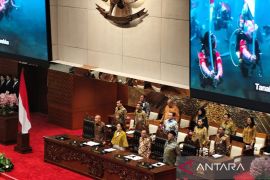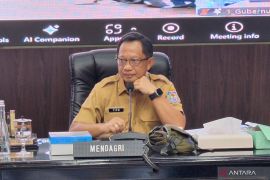Last year, despite various efforts to combat wildfires that had ravaged the countrys six provinces, especially Sumatra and Kalimantan Islands, in September and October, the hazardous haze emanating from the fires had led to 10 deaths, left 503 thousand people ill, and exposed around 43 million people to smoke.
Thousands of the two islands inhabitants had suffered from acute respiratory infection, eye and skin irritations, and pneumonia.
The haze emanating from the forest fires did not only harm the locals and the environment, but has also affected the financial performance of airways and state airport operator PT Angkasa Pura II.
PT Angkasa Pura II had suffered an estimated loss of Rp30 billion during the past month due to the haze, and some three thousand flights were affected over the September 1 to October 10 period alone, due to the haze.
Airports in Jambi and Pekanbaru (Riau Province) in Sumatra and in Pontianak (West Kalimantan Province) had to be frequently shut down due to poor visibility.
The World Bank recorded that forest and plantation fires, which had ravaged Indonesia last year, inflicted material losses worth trillions of rupiah, in addition to the operational costs involved in extinguishing the fires.
In November 2015, President Joko Widodo (Jokowi) visited Riau to supervise the efforts to put out the fires. He also went to Kalimantan for the same reason.
This year, the government has intensified efforts to combat the fires as early as possible by deploying joint teams that included military and police personnel.
This is in line with President Jokowis instructions issued last January that whenever a fire breaks out, it should be tackled immediately.
The president has reminded all rank and file of the need to take steps as early as possible to prevent a recurrence of the 2015 land and forest fires
Environmental Affairs and Forestry Minister Siti Nurbaya claimed that the number of forest fire cases had dropped drastically by 75 percent until August this year, compared to last year.
The significant drop was the result of the hard work of the forest fire task force comprising military and police personnel, among others.
The Indonesian Air Force and the National Disaster Mitigation Agency (BNPB) have deployed a number of helicopters and air tractors to carry out water bombing, as well several planes to make artificial rain.
A total of 88 thousand hectares of forest, peatland, and land areas across Indonesia were gutted by fires, a drop from 190 thousand hectares in the same period last year, according to Nurbaya.
Legal enforcement measures have also been intensified against forest arsonists, including farmers, using the slash and burn method that lead to uncontrolled fires on their farmlands.
The National Police have handled 498 cases of forest fire across Indonesia until August 2016, compared to last years 275 cases, including those involving nine companies that are still being investigated.
However, unfortunately, over the past week, haze is reportedly back in several towns in Riau and West Kalimantan Provinces particularly.
NASAs Terra and Aqua Satellites detected 167 hotspots across Sumatra Island in the morning of Aug. 29, a drastic increase from only 50 hotspots on the previous day.
The hotspots were found in seven provinces, including 145 hotspots, or 86 percent of them, in Riau.
Some eight hotspots were detected in South Sumatra Province; four in Jambi; two in West Sumatra; and one hotspot each in Bangka Belitung, Riau Islands, and North Sumatra.
Most of the fires were started by local farmers who practiced the slash and burn method to clear farmlands, mostly in peatland areas, according to reports.
The slash and burn method is banned, except in a farm measuring less than two hectares and having good fire control management.
In line with Law No. 32 of 2009 on environmental protection and management, forest and plantation arsonists could face up to 15 years in jail and a fine worth Rp15 billion maximally if the fire leads to any casualties.
The Indonesian police have arrested more than 450 suspects in connection with land and forest fires this year as part of a wider move to get tough on errant farmers and companies that still insist on using the outlawed slash-and-burn land clearing method.
"The number of people arrested this year has risen compared to last year," National Police Chief General Tito Karnavian informed the media on Aug. 25.
In Riau, the National Police's Criminal Investigation Agency (Bareskrim) has detained 85 forest fire individual suspects this year.
"In addition, nine companies are being investigated for alleged involvement in forest fires," Bareskrim chief Insp. Gen. Ari Dono Sukmanto said in Jakarta, on Aug. 25.
In Pontianak, Military District Command (Kodim) 1207/BS Pontianak has detained 38 people suspected of setting fires in West Kalimantan forest area in August 2016.
"Of the 38 suspects, 36 are farmers who clear their farm lands by setting fire to them, and one cleared land the same way for housing construction," Commander of Kodim 1207/BS Pontianak, Colonel (Inf) Jacky Ariestanto said here, Friday.
Another suspect cleared land by using fire for a palm oil plantation, he added.
"The perpetrator from a plantation company management was considered careless because he failed to put out the fire in his plantation area," he said.
The suspects have been handed over to the local police for further investigation.
Each year wildfires destroy 6 to 14 million hectares of fire-sensitive forests worldwide, a rate of loss and degradation comparable to that of destructive logging and agricultural conversion, according to the Food and Agriculture Organization (FAO).
The World Conservation Union (IUCN), The Nature Conservancy (TNC) and The Worldwide Fund for Nature (WWF) have come together to work proactively with multi-lateral agencies, governments, private sector and local communities to develop integrated fire management approaches that address underlying causes and develop long-term sustainable solutions.
The core elements of such an approach must include: building awareness amongst policy-makers, the public and the media of the underlying causes of catastrophic forest fires; and discouraging land management practices that predispose forests to harmful fires.(*)
Reporter: Fardah
Editor: Heru Purwanto
Copyright © ANTARA 2016










